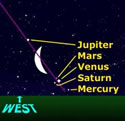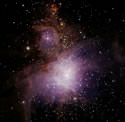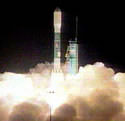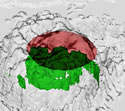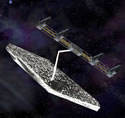
Image credit: NASA
NASA has selected two new concepts to advance the search for extrasolar planets; one of the technologies will eventually be selected for the Terrestrial Planet Finder mission. The first choice involves the use of an Infrared Interferometer, where multiple spacecraft will simulate a much larger observatory and search for the infrared signature of a planet around a distant star. The other concept is a Visible Light Coronagraph; a telescope 4 times as large and 10 times as powerful as Hubble, capable of imaging distant planets directly. NASA will choose one path in 2005-2006.
As part of its quest to find Earth-sized planets around stars and look for telltale chemical signatures of life, NASA has chosen two mission architecture concepts for further study and technology development.
The two architectures are being explored for the Terrestrial Planet Finder mission. Each would use a different means to achieve the same goal ? to block the light from a parent star in order to see its much smaller, dimmer planets. That technology challenge has been likened to finding a firefly near the beam of a brilliant searchlight from far away. Additional goals of the mission would include characterizing the surfaces and atmospheres of newfound planets, and looking for the chemical signatures of life.
The two candidate architectures are:
— Infrared Interferometer: Multiple small telescopes on a fixed structure or on separated spacecraft flying in precision formation would simulate a much larger, very powerful telescope. The interferometer would utilize a technique called nulling to reduce the starlight by a factor of one million, thus enabling the detection of the very dim infrared emission from the planets.
— Visible Light Coronagraph: A large optical telescope, with a mirror three to four times bigger and at least 10 times more precise than the Hubble Space Telescope, would collect starlight and the very dim reflected light from the planets. The telescope would have special optics to reduce the starlight by a factor of one billion, thus enabling astronomers to detect the faint planets.
The Terrestrial Planet Finder project at NASA?s Jet Propulsion Laboratory, Pasadena, Calif., selected the two candidates based on results from four industrial-academic teams that conducted a 2-1/2 year study of more than 60 possible designs. The two architectures were determined to be sufficiently realistic to warrant further study and technological development in support of a launch of Terrestrial Planet Finder by the middle of the next decade.
NASA and JPL will issue calls for proposals seeking input on the development and demonstration of technologies to implement the two architectures, and on scientific research relevant to planet finding. It is anticipated that one of the two architectures will be selected in 2005 or 2006 to be implemented for the mission, which may include international collaboration.
Terrestrial Planet Finder is part of NASA?s Origins Program, a series of missions to study the formation of galaxies, stars and planets, and to search for life. The program seeks to answers the questions: Where did we come from? Are we alone?
More information on the Terrestrial Planet Finder is available at http://tpf.jpl.nasa.gov/ .
More information on the Origins Program is available at http://origins.jpl.nasa.gov . Additional information on JPL?s planet-finding missions is available at http://planetquest.jpl.nasa.gov/ .
JPL manages the Terrestrial Planet Finder mission and the Origins Program for NASA’s Office of Space Science, Washington, D.C. JPL is a division of the California Institute of Technology in Pasadena.
Original Source: NASA News Release

